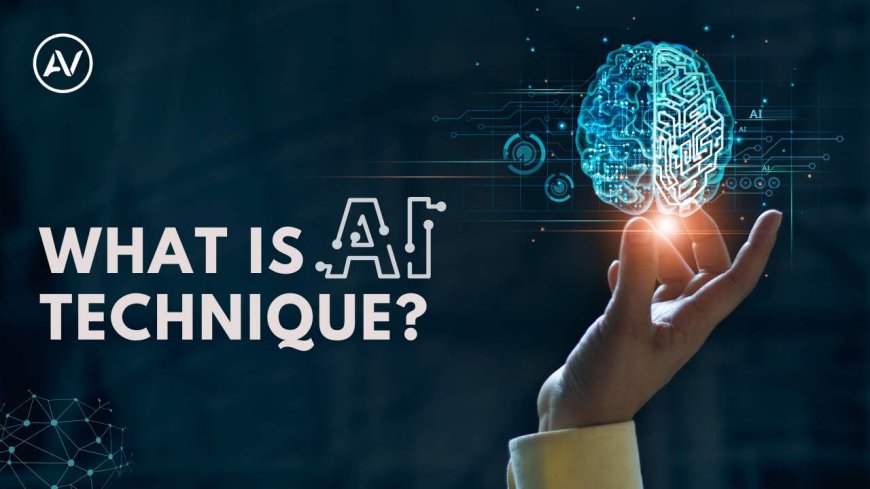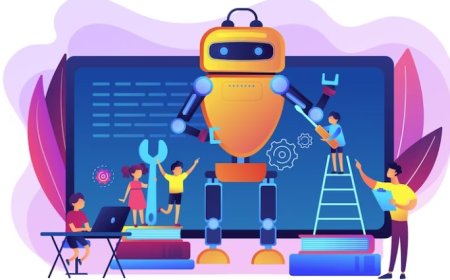Explore: What is AI Technique?
Discover AI techniques, algorithms, machine learning, data, models, neural networks, applications, technology, innovation, and automation.

The wide range of approaches and methods used to imbue machines with intelligence and replicate human cognitive capacities is referred to as artificial intelligence (AI) techniques. These cover a broad range of methodologies, from state-of-the-art machine learning and neural networks to conventional symbolic reasoning.
What is AI technique?
Understanding the specifics of artificial intelligence (AI) methodology is essential since it forms the basis for creating intelligent systems that spur innovation in a variety of industries. The application of artificial intelligence has a wide range, including improving transportation logistics, refining entertainment experiences, financial decision-making, and healthcare diagnostics. Additionally, a thorough comprehension of AI techniques promotes cooperation between humans and machines by allowing the harmonious integration of Artificial intelligence and human intelligence. People may effectively use the power of intelligent systems and spur innovation and advancement in a quickly changing technological world by understanding the underlying workings of AI techniques.
Evolution of AI Techniques
Over time, techniques for artificial intelligence have evolved significantly. Initially, machines processed data by following rules. After that, they began to learn from the data themselves and improved with time. They can now perform complicated tasks like language comprehension and image recognition because of deep learning. Due to these developments, AI is now utilized in a wide range of industries, including healthcare, banking, entertainment, and transportation. AI aids in patient diagnosis and treatment in the healthcare industry. It facilitates trading and risk management in the financial world. AI helps transportation by enabling autonomous automobile driving and route optimization. AI-powered movie and television recommendations improve entertainment. AI will continue to have a significant impact on many aspects of our life as it develops.
Types of AI Techniques
Types of AI Techniques refer to different ways machines learn and solve problems. They include rule-based systems, machine learning, and deep learning, each with its own strengths and applications.
Machine learning
Machine learning is a branch of artificial intelligence where algorithms enable computers to learn from data and improve their performance on specific tasks without being explicitly programmed.
-
Supervised Learning: Using labeled data, the algorithm learns by making decisions or predictions based on previous instances.
-
Unsupervised Learning: In unsupervised learning, an algorithm searches the input data for hidden patterns or structures while learning from unlabeled data.
-
Reinforcement Learning: Reinforcement learning is a trial-and-error learning technique in which an agent gains decision-making skills by interacting with its surroundings and getting input in the form of incentives or punishments.
Deep Learning
Deep learning is a kind of machine learning that makes use of multi-layered artificial neural networks to extract knowledge from massive datasets. By trying to replicate the structure and operations of the human brain, it will be possible for computers to carry out complex tasks like decision-making, image recognition, and natural language processing.
-
Neural Networks: Neural networks are computer systems that are modeled after the structure of the human brain. They are made up of interconnected nodes, or neurons, that process and send data. They have layers of connected neurons that allow them to learn intricate patterns from data.
-
Convolutional neural networks(CNNs): It is a special kind of neural network that functions well with input that resembles a grid, like photographs. Their use of convolutional layers enables them to recognize features in the input data automatically, which makes them ideal for applications like image recognition and classification.
-
Recurrent Neural Networks (RNNs): RNNs are neural networks that remember previous inputs to analyze sequential data. As a result, they can demonstrate temporal dynamics and perform well on tasks like time series prediction, language translation, and speech recognition.
Natural Language Processing (NLP)
Natural Language Processing (NLP) is a field of artificial intelligence where computers understand, interpret, and generate human language in a way that's easy for us to use. It helps computers communicate with humans more naturally, enabling tasks like language translation, text summarization, and sentiment analysis.
Computer Vision
Computer Vision is a branch of artificial intelligence that enables computers to interpret and understand visual information from the real world, such as images and videos. It involves tasks like image recognition, object detection, and image segmentation, allowing computers to perceive and analyze visual data similar to how humans do.
Expert Systems
Genetic Algorithms are computer programs that solve problems by imitating the way living things evolve. They start with a bunch of possible solutions, then mix and change them over time until they find the best one. It's like nature's way of problem-solving but done by computers.
How AI Techniques Work
AI techniques function by analyzing data and drawing conclusions from it in order to carry out tasks or make judgments. Fundamentally, they are predicated on a few fundamental ideas:
Processing of Data: AI methods start by absorbing vast volumes of data, which can be text, pictures, or numerical data.
Pattern Recognition: These methods examine the data to find links and patterns that aid in understanding the information's underlying structure.
Learning Algorithms: AI systems employ learning algorithms to examine data patterns and draw insightful conclusions. This entails modifying the algorithms' weights or parameters to enhance performance over time.
Decision Making: AI systems establish predictions or judgments to address certain issues or accomplish desired results based on the patterns seen in the data and the insights obtained from it.
Input Loop: AI systems are always getting input on how they're doing, which helps them hone their algorithms and increase efficiency and accuracy.
These fundamental ideas enable AI systems to accomplish a multitude of tasks, including object recognition in photos, natural language comprehension, and recommendation-making.
Applications of AI Techniques
A. Healthcare: AI methods assist physicians in patient monitoring, therapy planning, and diagnosis. AI intelligence helps medical practitioners by analyzing data.
B. Finance: AI methods evaluate risks, identify fraud, and automate trade. Financial data is analyzed by AI intelligence to improve decision-making and operations.
C. Marketing and Sales: AI methods are used to predict sales, segment customers, and tailor campaigns. AI intelligence examines consumer behavior to enhance advertising tactics.
D. Transportation: AI tools facilitate autonomous vehicle navigation, traffic management, and route optimization. Sensor data is processed by AI intelligence to provide safer and more effective transportation.
E. Manufacturing: AI methods automate procedures, regulate quality, and forecast maintenance requirements. Sensor data is analyzed by AI intelligence to maximize output and minimize downtime.
F. Entertainment: AI techniques personalize recommendations, analyze content, and create immersive experiences, enriching entertainment options.
G. Security and Surveillance: AI techniques identify threats, monitor activities, and enhance surveillance systems, ensuring safety and security.
Future Trends in AI Techniques
AI will get smarter with new research, focusing on better algorithms like deep learning. It will team up with new AI technology for cooler applications, while also becoming more reliable and ethical.
Advancements in Research and Development:
-
In order to improve AI systems, scientists and engineers will look into innovative algorithms, architectures, and techniques.
-
There will be advancements in fields including natural language processing, reinforcement learning, and deep learning.
-
These developments will open the door for increasingly complex AI applications in a variety of fields.
-
The development of AI methods that are more reliable, understandable, and moral will be a priority.
-
Taking care of the present issues and restrictions related to the use of AI will be a top priority.
Integration with Emerging Technologies:
-
AI techniques will merge with emerging technologies, opening new doors for applications.
-
Technologies like blockchain, IoT, and AR will enable AI to use diverse data sources and interact better with the real world.
-
AI-powered IoT devices can improve predictive maintenance in smart factories.
-
AI-driven AR applications will enhance customer experiences in retail and entertainment.
-
The combination of AI with quantum computing, edge computing, and 5G networks will boost data processing speed and efficiency, leading to more innovation across industries.
In conclusion, our research into AI methods showed their significant influence on modern technology and society. We've discovered the complex inner workings of AI systems, from comprehending the fundamentals of data processing and pattern recognition to exploring modern methods like deep learning and reinforcement learning. AI approaches have a bright future ahead of them thanks to continuous research improvements and their integration with developing technology. These patterns show that AI systems are continuing to advance toward greater intelligence and capability, which could transform many sectors of the economy and enhance our quality of life. But even with this quick advancement, it's important to remember moral issues and make sure that technology is used responsibly. We can fully realize the promise of AI techniques to tackle intricate problems and usher in a more optimistic and interconnected future by judiciously utilizing their power.





































